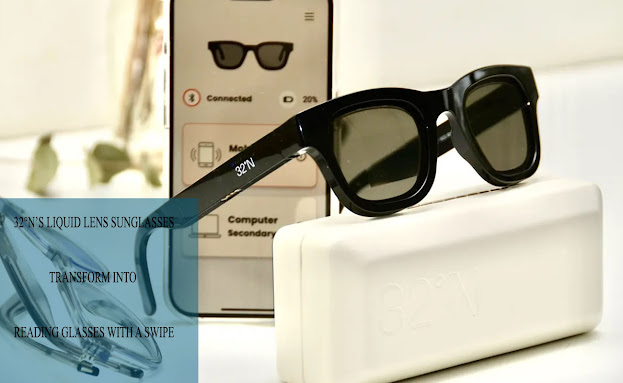32°N’s Liquid Lens Sunglasses Transform into Reading Glasses with a Swipe
The nerd emoji is recognisable by their glasses, ��� but when those lenses take on a dark hue, both the emoji and you become hip. ��� Reading glasses are for old people, and glasses with chips are for "glassholes." We can all agree that nothing is lamer than an over-40-year-old like myself.
What would happen if you combined reading glasses with sunglasses and covertly implanted a chip so that no one would ever know?
With its most recent Muir sunglasses, which I've been trying for the past few weeks under the 32°N brand, Deep Optics has achieved just that. To focus on nearby objects, a swipe across the frame modifies the states of millions of tiny pixels by sending an electrical signal to the two liquid crystal lenses.
Thus, for $849 of your hard-earned money, 32 Degrees North promises to eliminate the need for you to carry around (and misplace) both reading glasses and sunglasses.
32 Degrees North Muir Features
l Magnification range:0 to 2.5
l 100 per cent UV protection
l Polarized lenses
l Anti-reflective coating
l Anti-scratch coating
l 45g, so not overly heavy
l Battery lasts about five hours with active use
l Charges in about two hours
l Small LED indicator glows red if the battery needs charging
The Good of 32 Degrees North Muir
l Eliminates the need to carry both sunglasses and reading glasses
l Looks good on many people
l Technology works for the most art
l Easy to set up
The Bad of 32 Degree North Muir
l Expensive
l Have to sometimes hunt for the narrow sweet spot needed for reading
l Lastic frames don’t feel premium
32 Degrees North Muir General Review
The Bluetooth radio may be paired by triple-tapping the right temple's frame. The 32°N phone app has a really good video explainer that guides you through each stage of the setup process, making it quick. If you would rather have a personal touch, the company also provides guided one-on-one video onboarding sessions. In any case, you find out just how limiting those liquid crystal lenses are during setup.
The entire lens of a normal reading glass is a magnifier, so it's useful for viewing objects close by. For this reason, you frequently see folks in their mid-40s and older putting them on and off.
On the new Muir frame, however, a simple swipe from the right temple towards the ear changes the squared-off area of each lens where the active liquid crystal lens is located, not the lenses as a whole into magnifiers. In other words, something akin to an on-demand bifocal—a lens inside a lens.
Additionally, a small, active sweet spot provides magnification inside that square; everything else in the area becomes blurry. When your head and eyes are positioned correctly, I can read roughly five lines of smartphone text at default settings with that narrow magnification band. I have to turn my head to view more.
It's helpful to rapidly see around you without having to swipe to turn off magnification. Everything outside that liquid crystal square is an unchanged "safety zone" with no magnification at all.
With one more swipe from the temple back, the reading glasses completely transform into sunglasses. The lenses can also be seen hanging from the outside, but only in specific lighting conditions, at specific angles, and with extremely close inspection.
In actual use, everything functions as intended. However, because the liquid crystal lens takes some getting used to, it takes some time to feel natural. Even after testing for several hours, I still find myself looking for the perfect spot with my head or eyes and shifting my position to read things. Conversely, the movements quickly became second nature.
The lens smears when you swipe for magnification and then focuses again in two to three seconds. Although it seems sluggish, it's far quicker than removing your reading glasses. It is quicker and more seamless to swipe again to return to wearing simple sunglasses.
The magnification focal distance can be switched between three settings by swiping in reverse from the ear to the temple: watch mode (very close), smartphone (close), and laptop (not so close). The attention shift is modest but significant. I have mine set to alternate between my phone and laptop, where I read most of the time.
Several fingers pressed against the temple switch the lenses into your preferred reading mode—a smartphone for me—and they remain there for two seconds after the hand is released. This turned out to be a really practical gesture for reading notifications on your phone, a payment terminal, or anything else you need to quickly read nearby.
However, $849 is a steep price to pay for these, especially considering that a good quality, multi-focal prescription pair of polarised sunglasses can be purchased for about $500.
Liquid crystal lens technology has an indisputable cool factor ���, and any ageing Gen Zer would appreciate how convenient it is to only need to carry (and take care of) one pair of glasses. Since they and I were the first generation to grow up with personal computers, it makes sense that they should receive the first computerised reading glasses.
Ultimately, I would advise trying these new Muir adaptive sunglasses out before making a purchase. 32°N makes this easy with a 30-day money-back guarantee.
Reference





Post a Comment
0 Comments